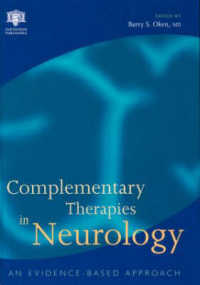Full Description
This classic novel tells the story, in letters, of the beautiful and virtuous Clarissa Harlowe's pursuit by the brilliant, unscrupulous rake Robert Lovelace. The epistolary structure allows Richardson to create layered and fully realized characters, as well as an intriguing uncertainty about the reliability of the various "narrators." Clarissa emerges as a heroine at once rational and passionate, self-sacrificing and defiant, and her story has gripped readers since the novel's first publication in 1747-1748.
This new abridgment is designed to retain the novel's rich characterizations and relationships, and reproduces individual letters in their entirety whenever possible. This Broadview Edition provides a uniquely accessible entry point for readers, while retaining much of the powerful reading experience of the complete novel.
Contents
Acknowledgements
Introduction
Samuel Richardson: A Brief Chronology
A Note on the Text
Clarissa
Appendix A: Prefatory Material for the Second Edition, 1749
Appendix B: Richardson's Correspondence
Correspondence with "Mrs. Belfour"/Lady Bradshaigh (1748-53)
Letter 1: Lady Bradshaigh to Richardson
Letter 2: Richardson to Lady Bradshaigh
Letter 3: Lady Bradshaigh to Richardson
Letter 4: Richardson to Lady Bradshaigh
Letter 5: Richardson to Lady Bradshaigh
Correspondence with Johannes Stinstra (1753-54)
Letter 1: Richardson to Johannes Stinstra
Letter 2: Johannes Stinstra to Richardson
Letter 3: Richardson to Johannes Stinstra
Appendix C: Eighteenth-Century Responses to Clarissa
Henry Fielding, Letter to Richardson (1748)
Sarah Fielding, Letter to Richardson (1749)
Review of Clarissa by Albrecht Von Haller (1749)
Review of Clarissa by Samuel Johnson (1750)
Elizabeth Echlin, An Alternative Ending to Richardson's Clarissa (1754-55)
Denis Diderot, "In Praise of Richardson" (1761)
From James Beattie, "On Fable and Romance" (1783)
Anna Lætitia Aikin Barbauld, "The Life of Samuel Richardson, with Remarks on His Writings" (1804)
Select Bibliography







